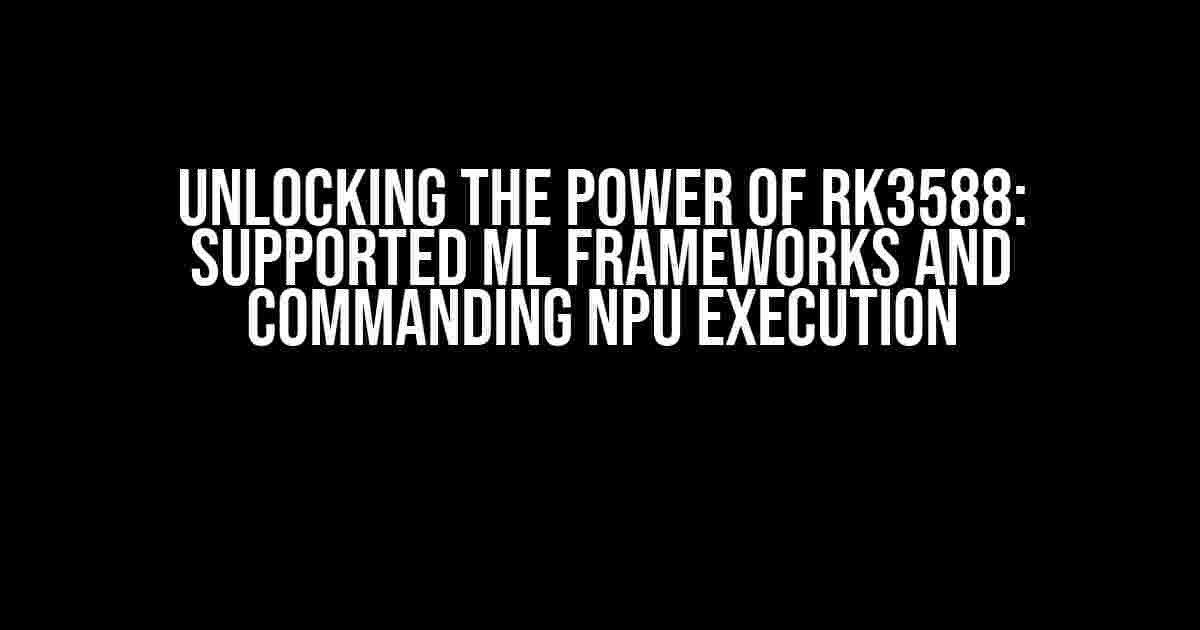The RK3588, a powerful AI-enabled System-on-Chip (SoC), has taken the tech world by storm with its impressive Neural Processing Unit (NPU) capabilities. As developers and engineers, we’re excited to dive into the world of machine learning (ML) and explore the supported frameworks and commanding NPU execution on this remarkable chip. Buckle up, folks, as we embark on this comprehensive journey!
Supported ML Frameworks on RK3588
The RK3588 boasts an impressive lineup of supported ML frameworks, making it an ideal choice for a wide range of applications. Let’s take a closer look at the frameworks that make the cut:
- TensorFlow Lite: A lightweight version of the popular TensorFlow framework, optimized for mobile and embedded devices.
- Caffe: A popular, open-source deep learning framework that’s widely used in the industry.
- Caffe2: A lightweight, cross-platform version of Caffe, optimized for mobile and embedded devices.
- OpenVINO: An open-source framework that enables inference of deep learning models on various hardware platforms, including RK3588.
- PyTorch: A popular, open-source ML framework that’s widely used in research and development.
These frameworks provide a solid foundation for building and deploying ML models on the RK3588, catering to various use cases and applications.
Commanding NPU Execution on RK3588
To fully unleash the power of the RK3588’s NPU, we need to understand the commands and protocols that govern its execution. Let’s delve into the world of NPU execution and explore the following topics:
NPU Execution Modes
The RK3588’s NPU supports two primary execution modes:
- Normal Mode: In this mode, the NPU executes ML inference tasks using the available system resources.
- Boost Mode: This mode unlocks the NPU’s full potential, dedicating all available system resources to ML inference tasks, resulting in significant performance boosts.
Developers can switch between these modes using the rk_npu_set_mode() function, which takes a single argument specifying the desired mode.
NPU Command Queue
The RK3588’s NPU command queue is responsible for handling and executing ML inference tasks. To interact with the queue, developers can use the following functions:
rknpu_queue_t *rk_npu_create_queue();
rknpu_job_t *rk_npu_create_job(rknpu_queue_t *queue, ...);
int rk_npu_enqueue_job(rknpu_queue_t *queue, rknpu_job_t *job);
int rk_npu_dequeue_job(rknpu_queue_t *queue, rknpu_job_t **job);
These functions enable developers to create and manage command queues, jobs, and tasks, ensuring seamless NPU execution and efficient resource utilization.
NPU Synchronization
To ensure correct NPU execution and avoid data corruption, synchronization is crucial. The RK3588 provides two synchronization mechanisms:
- Fence-based Synchronization: Utilizes the
rknpu_fence_tstructure to create fences, which are used to synchronize NPU execution with other system components. - Semaphore-based Synchronization: Employing semaphores to synchronize access to shared resources, preventing data corruption and ensuring correct NPU execution.
By mastering these synchronization mechanisms, developers can ensure reliable and efficient NPU execution on the RK3588.
Optimizing ML Model Execution on RK3588
Optimizing ML model execution is crucial for achieving peak performance on the RK3588. Here are some expert tips to help you get the most out of your models:
Model Pruning and Quantization
Pruning and quantizing ML models can significantly reduce computational complexity and memory requirements, resulting in faster execution times and improved performance.
Popular frameworks like TensorFlow Lite and OpenVINO provide built-in support for model pruning and quantization, making it easier to optimize your models for the RK3588.
Batching and Tiling
Batching and tiling are two techniques used to optimize ML model execution on the RK3588:
- Batching: Processing multiple input samples in parallel to reduce the number of inference tasks and improve overall throughput.
- Tiling: Dividing large input samples into smaller, more manageable tiles, enabling efficient processing and reduced memory usage.
By applying these techniques, developers can optimize their ML models for the RK3588, achieving significant performance improvements and efficient resource utilization.
Exploiting RK3588’s Hardware Accelerators
The RK3588 features a range of hardware accelerators, including the NPU, GPU, and VPU. By leveraging these accelerators, developers can offload computationally intensive tasks, reducing the load on the CPU and improving overall system performance.
For example, the NPU can be used to accelerate ML inference tasks, while the GPU can handle graphics and compute-intensive tasks. By cleverly utilizing these hardware accelerators, developers can create highly optimized and efficient systems.
Conclusion
In conclusion, the RK3588 offers an impressive range of supported ML frameworks and commanding NPU execution capabilities, making it an ideal choice for developers and engineers working on AI-enabled projects. By mastering the art of NPU execution, optimizing ML model execution, and exploiting the RK3588’s hardware accelerators, you can unlock the full potential of this remarkable chip and create innovative, high-performance solutions.
So, what are you waiting for? Get started with the RK3588 today and unleash the power of AI in your next project!
| Framework | Description |
|---|---|
| TensorFlow Lite | A lightweight version of TensorFlow, optimized for mobile and embedded devices. |
| Caffe | A popular, open-source deep learning framework widely used in the industry. |
| Caffe2 | A lightweight, cross-platform version of Caffe, optimized for mobile and embedded devices. |
| OpenVINO | An open-source framework that enables inference of deep learning models on various hardware platforms, including RK3588. |
| PyTorch | A popular, open-source ML framework widely used in research and development. |
Frequently Asked Question
Get ready to unleash the power of machine learning on the RK3588! Here are some frequently asked questions about supported ML frameworks and commanding NPU execution.
Which machine learning frameworks are supported on the RK3588?
The RK3588 supports popular machine learning frameworks such as TensorFlow, TensorFlow Lite, Caffe, and PyTorch, allowing developers to easily integrate their ML models into their applications.
Can I use OpenVINO on the RK3588?
Yes, the RK3588 is compatible with OpenVINO, which provides optimized acceleration for deep learning inference. This allows developers to optimize their models for the NPU and achieve better performance.
How do I command NPU execution on the RK3588?
To command NPU execution on the RK3588, developers can use the Rockchip NPU SDK, which provides a set of APIs and tools to interface with the NPU. This allows developers to offload ML computations to the NPU and leverage its acceleration capabilities.
Can I use the RK3588 for both inference and training?
Yes, the RK3588 is capable of both inference and training. Its NPU can accelerate ML computations for inference, while its CPU and memory resources can be utilized for training. This makes the RK3588 a versatile platform for machine learning development.
Are there any development tools available for the RK3588?
Yes, Rockchip provides a range of development tools and resources for the RK3588, including the NPU SDK, compiler, and model optimization tools. These tools help developers to optimize and deploy their ML models on the RK3588 efficiently.


